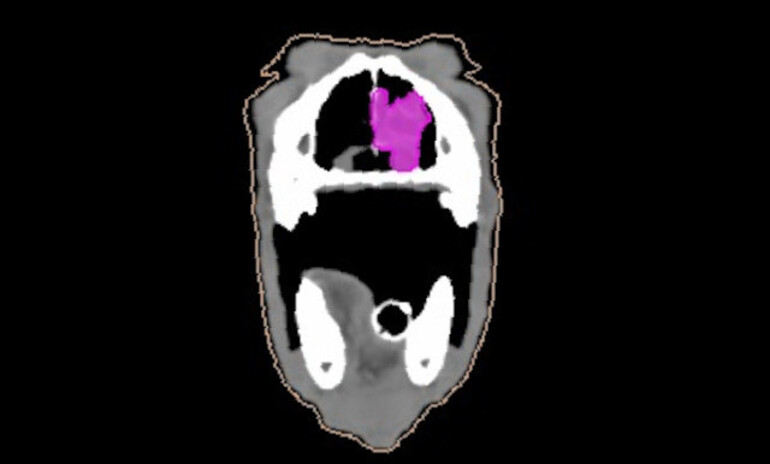![[Translate to English:] Hund schaut an Kamera vorbei](/fileadmin/user_upload/img/header/h-hd.jpg)
Warning signs: nasal discharge
Nasal cavity and paranasal sinus tumors in dogs
von Dr. Alena Soukup & Team // 24. January 2025
Tumors of the nasal cavity and paranasal sinuses occur in about 1% of the dog population. Typically, these are older patients with an average age of 10 years. These tumors originate from cells of the nasal mucosa or the surrounding connective tissue. A distinction is made between tumors depending on the tissue of origin. If it is glandular tissue, it is referred to as adenocarcinoma or adenoma. If the tumor originates from epithelial cells, it is a squamous cell carcinoma or papilloma. If the tumor originates from connective tissue or cartilage, it is referred to as fibrosarcoma, chondrosarcoma or, in the case of less differentiated tumors, just sarcoma. In some cases, it is not even possible to identify the tissue of origin as the cells are not sufficiently differentiated.
What are the symptoms of a nasal cavity tumor or a sinus tumor?

The clinical symptoms of a tumor of the nose can vary greatly. Affected patients often show nasal discharge, which can be purulent, but nosebleeds, sneezing or so-called backward sneezing are also possible.
Neurological symptoms are also possible with tumors in the posterior part of the nasal cavity that have already broken through the bony boundary between the nasal cavity and the brain. Sometimes these patients initially experience epileptic seizures. At an advanced stage, all tumors can lead to so-called bone lysis, i.e. the adjacent bones dissolve. They can grow behind the eye or under the skin of the bridge of the nose and cause facial asymmetry and a protruding eye, an exophthalmos.

Reverse sneezing
Any nasal discharge, whether bloody or purulent, and any persistent reverse sneezing should be thoroughly investigated and clarified. Endoscopy and computer tomography (CT), among other things, are available for this purpose. The earlier tumors are detected and the sooner treatment begins, the better the prognosis.
Nasal cavity and paranasal sinus tumors: Always malignant?
Unfortunately, most tumors of the nasal cavities and paranasal sinuses are malignant, i.e. carcinomas or sarcomas. The main characteristic of these tumors is their infiltrative growth into the surrounding tissue. They therefore cause problems locally. The risk of metastases remains low with these tumors. However, up to 10 % of patients show metastases in the regional lymph nodes. Metastasis to the lungs is rare. Nevertheless, thorough staging should be carried out due to this risk. In general, the staging of these tumors includes a puncture of the mandibular lymph nodes (mandibular lymph nodes), sometimes also other lymph nodes of the neck (retropharyngeal lymph node). A chest X-ray and, if necessary, an abdominal ultrasound should also be performed.
How can nasal cavity tumors or paranasal sinus tumors be treated?
The type of tumor should be known in order to select the right therapy. Due to the infiltrative nature of the tumors, surgery is not recommended in most cases without subsequent radiotherapy, as these tumors tend to grow again within a few weeks, i.e. to recur. In addition, complete surgery is sometimes impossible due to the turbinates.
Radiotherapy has been the treatment of choice for years, as it treats not only the visible part of the tumor but also the non-visible infiltrative parts. In general, there are various protocols that can be used. At EQUINOX HEALTHCARE GmbH, we mainly use a hypofractionated protocol consisting of ten sessions, daily Monday to Friday, over two weeks. If this protocol is not suitable, a protocol with five sessions can be used as an alternative.
In order for a nasal cavity or paranasal sinus tumor to be irradiated, a computer tomography scan is required as a planning CT. A special positioning aid with a bite block, a dental impression and a vacuum mattress is produced. The sectional images are used to create an individual radiation plan in a special computer-based planning system. This procedure makes it possible to irradiate the tumor with a high dose while sparing the surrounding normal tissue.

Precision for better compatibility
We use individual positioning aids such as vacuum mattresses, bite impressions and bite wedges for precise and accurate irradiation of nasal cavity tumors. Plastic masks are only used at Equinox Healthcare in exceptional cases, as they rarely improve accuracy.
In which breeds do nasal cavity or paranasal sinus tumors occur particularly frequently?
There is no clear breed predisposition for a nasal cavity tumor. It is debated whether dog breeds with long noses, so-called dolichocephalic breeds, are more likely to develop nasal cavity tumors. However, it is also not uncommon for other dog breeds such as French Bulldogs or Golden Retrievers to be affected. However, there are environmental factors that increase the risk of developing a nasal cavity tumor, in particular environmental pollution and cigarette smoke.
What is the prognosis for the treatment of nasal cavity or paranasal sinus tumors?
The earlier a nasal cavity tumor is diagnosed, the better the chances of long-term tumor control. Small tumors can be controlled for an average of two years. In the case of very large tumors that have already broken through various bones, the average tumor control described is unfortunately only 6-9 months in some cases.

Important to know
The smaller the tumor and the earlier it is detected, the better the prognosis.
Every abnormality and every symptom should therefore be carefully investigated. The illustration shows the computer tomography of a dog with a tumor of the nasal cavity. The colored area has already been marked for the planning of radiotherapy. If the tumor is detected early, the animals can still breathe normally. In some cases, however, both nasal passages become completely blocked.


